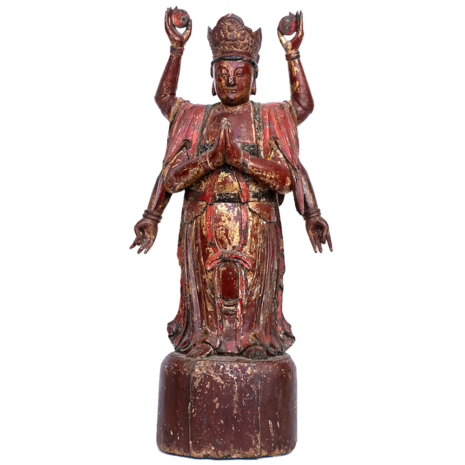Rare Antique Three-Faced Tantric Bodhisattva, China #16200
Original price was: $4,200.00.$3,400.00Current price is: $3,400.00.
H: 29.5″ W: D: | CALL 213-568-3030 OR EMAIL [email protected] FOR SHIPPING.
This rare antique carving is in typical Tantric style with 6 arms and 3 faces, 1 facing front and 2 at the rear. She hold discs of the Sun and Moon, hands in anjali, the mudra of prayer and ones in vitarka-mudra, the teaching gesture. Multi-heads and arms symbolize the ability to save many living beings at one time.
Description
This statue reflects the Tantric Buddhism (Vajrayana or Esoteric) tradition involving mystical concepts and practices, elaborate rituals and a strong hierarchical structure that departs from mainstream Buddhism. Many Chinese Buddhist, Taoist and Tantric deities are either very difficult to identify or are confused with other divinities, as they are sometimes presented without identifying attributes or have unusual features. This is Chun-ti P’u-sa the Bodhisattva of Light, (Stevens) worshipped by Chan (Zen) Buddhists. She often has several faces; this image has three. Regarded as a manifestation of Guanyin, both swore to deliver all beings from suffering before they entered nirvana. According to legend, Chun-ti P’u-sa was summoned to Heaven to challenge K’ung Hsuan, a competitor for the dynastic throne. She was whisked aloft by a rainbow and, having acquired the necessary skills, reappeared in a fire cloud form with 24 heads and eighteen arms. Throwing a silken cord around her adversary, she turned K’ung Hsuan into a one-eyed peacock and rode him off to the Western Heavens. This antique carving is probably from Jiangsu Province and is rendered in typical Tantric style: she has six arms and a head with three faces, one facing front and two at the rear. Her upper hands hold discs of the Sun and Moon, the hands in the center are pressed at the chest with palms together in anjali, the mudra of prayer and the two lower hands are in vitarka-mudra, the teaching gesture. When Chun-ti P’u-sa or other bodhisattvas appear with multi-heads and arms, it symbolizes their ability to save many living beings at one time. (Reid) She is covered in gilt and red giving her a glowing radiance. She wears a finely carved elegant three lobed crown centered by Amitabha Buddha seated on a lotus throne (padmapitha) in a radiating aureole She has prominent pendulous ears symbolizing wisdom similar to depictions of Guanyin with whom she is often confused. This extremely rare piece is in very good condition with a dark lacquer patina, paint and some lacquer losses and one reattached arm which does not detract from its overall appearance, elegance and spirituality. The oval back cavity indicates it was consecrated.
Sources
Margret Reid, The Changing Face of Guanyin in East Asian Religions, Thesis requirement for Master of Arts in Religious Studies, University of Canterbury, 1977
Keith Stevens, Chinese Gods: The Unseen World of Spirits and Demons, Hong Kong, Collins & Brown, 1997.
Additional information
| Place of Origin | China |
|---|---|
| Period | Antique, Qing Dynasty |
| Date | 18-19th Century |
| Dimensions (inches) | Ht: 29.5” W: 14” D: 6.5” |
| Dimensions (metric) | Ht: 74.93cm W: 35.56cm D: 22.58cm |
| Materials and Technique | Wood |
| Item Number | 16200LBEM |
| Condition | Very good, has restorations/repairs (see description) |
| Shipping Box Size | Oversized. Call 213-568-3030 or email [email protected] for shipping. |












